In 1784, two years after the founding of Washington College, St. John’s College was chartered.[7] It was to be placed at Annapolis, and in it was merged the old county Academy, “King William’s School,” founded some eighty years before. By the same act, the two colleges were united in the University of Maryland. This University was modeled on the English type: the governor was to be its chancellor, and the governing body was to be the “Convocation of the University of Maryland.” The convocation was to be composed of seven members of the Board of Visitors and Governors and two of the faculty of each college; it was to establish ordinances for the government of the colleges, to cause a uniformity in the “manners and literature,” to receive appeals from the students, and to confer “the higher degrees and honors of the University.” Its meetings were to be annual, and to be held alternately at each college on its commencement day.
The provisions of the act were never carried out; two fruitless attempts were made to hold sessions of Convocation in 1790 and 1791, and then nothing was even attempted. So thoroughly was the project forgotten, that the Legislature of 1805, in withdrawing the State appropriations from the two colleges, did not even mention the University, and in 1812, though the old charter had never been repealed, there was no hesitation in bestowing the name of University of Maryland on a second institution.[8]
The two colleges which constituted this first University are still existing and doing good work. The elder, Washington College, lost Dr. Smith in 1788 by his return to Philadelphia and re-accession to his old position there. He was succeeded by Rev. Colin Ferguson, a native of Kent county, and educated at Edinburgh University. Under him the college continued to flourish, until the withdrawal of the State’s appropriation in 1805. The constitutionality of this withdrawal is questionable, as the original grant was to be paid annually “forever;” but the State refused to permit itself to be sued by the college and, some years later, on increasing its appropriation to the college, the legislature required a release of all claims on the State under the original act.
By the act of 1805, the activity of the college was paralyzed and its usefulness much impaired. It had not yet become strong enough to stand alone and, when the helping hand of the State was taken away, it was almost obliged to close its doors to students. Since that time the State has renewed its grants to the college and has greatly aided it in performing its functions; but from the disastrous effects of the act of 1805, the institution has never fully recovered.




